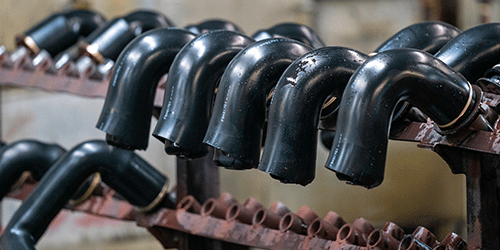Rubber, while in its original form, is literally useless. It is only in large chemical plants where different kinds of chemicals are added with various minerals like gas and petroleum to make rubber a useful resource and form its derivatives. This man made and artificial rubber is called synthetic rubber. The properties and characteristics of synthetic rubber are dependent on the chemicals used for its production, thus it can vary from being as a hard as a baseball or as soft as a pillow.
Given its polymer-like attributes, synthetic rubber, which is also known as Elastomers, can undergo temporary deformation and stretching under tension but can return to its original form as well, since its elasticity is not permanent.
There are numerous types of synthetic rubber being used across several industries, some of which are discussed below.
Also known as neoprene, this type of synthetic rubber is being used in over 15 industries since several decades. Having been developed as the original specialty elastomer, it stands today as one of the most important synthetic rubber types boasting a yearly consumption of around 300,000 tons globally. Given its supreme production quality, the rubber maintains an ideal balance of mechanical strength and oil and chemical resistance. Other properties of neoprene include weather and aging resistance, low flammability and the unique capability of bonding with other substrates.
Owing to its significant properties, neoprene plays a critical role in several industries as a raw material in both its original form and with other solvents. It is also used to produce gloves, cables and conveyor belts.
Chemically named as Ethylene propylene diene monomer, EPDM is also one of the most popular forms of synthetic rubber. It is a highly durable form of elastomers having extensive applications. Similar to neoprene, EPDM is also highly resistant to heat, weather and ozone aging while also being flexible at both low and high temperatures. An exclusive feature of the ethylene rubber is its resistance to liquids like water and acids.
As this rubber is considered the most water repellent amongst all types,it is deemed most appropriate for electrical filling and lamination while also being largely used in the automotive industry and construction plants.
Styrene butadiene rubber was originally developed in Germany in the early 1900s with its use growing increasing popular during World War II due to natural rubber becoming unavailable. Since then, SBR has become the most commonly used synthetic rubber due to its processability, good abrasion, and good aging resistance. Compared to natural rubber, its heat, oil and abrasion resistance is significantly better.
Styrene butadiene rubber can be polymerized in different ways, which changes its consistency and allows for many applications. SBR is most commonly used in vehicle tires; however, it has numerous uses including industrial hoses, conveyor belts, footwear, adhesives, gaskets, and molded or extruded rubber goods. It can also be used in building applications for sealing and binding.
